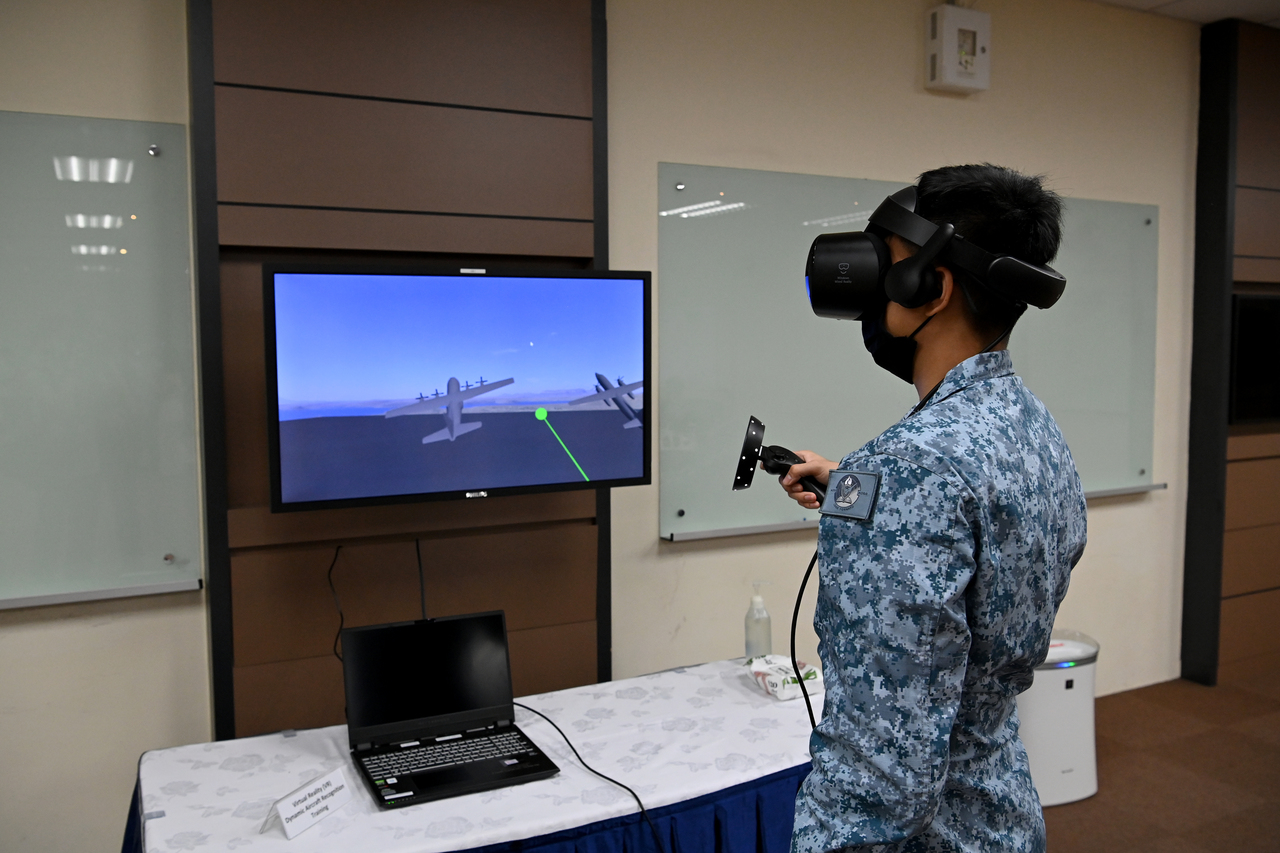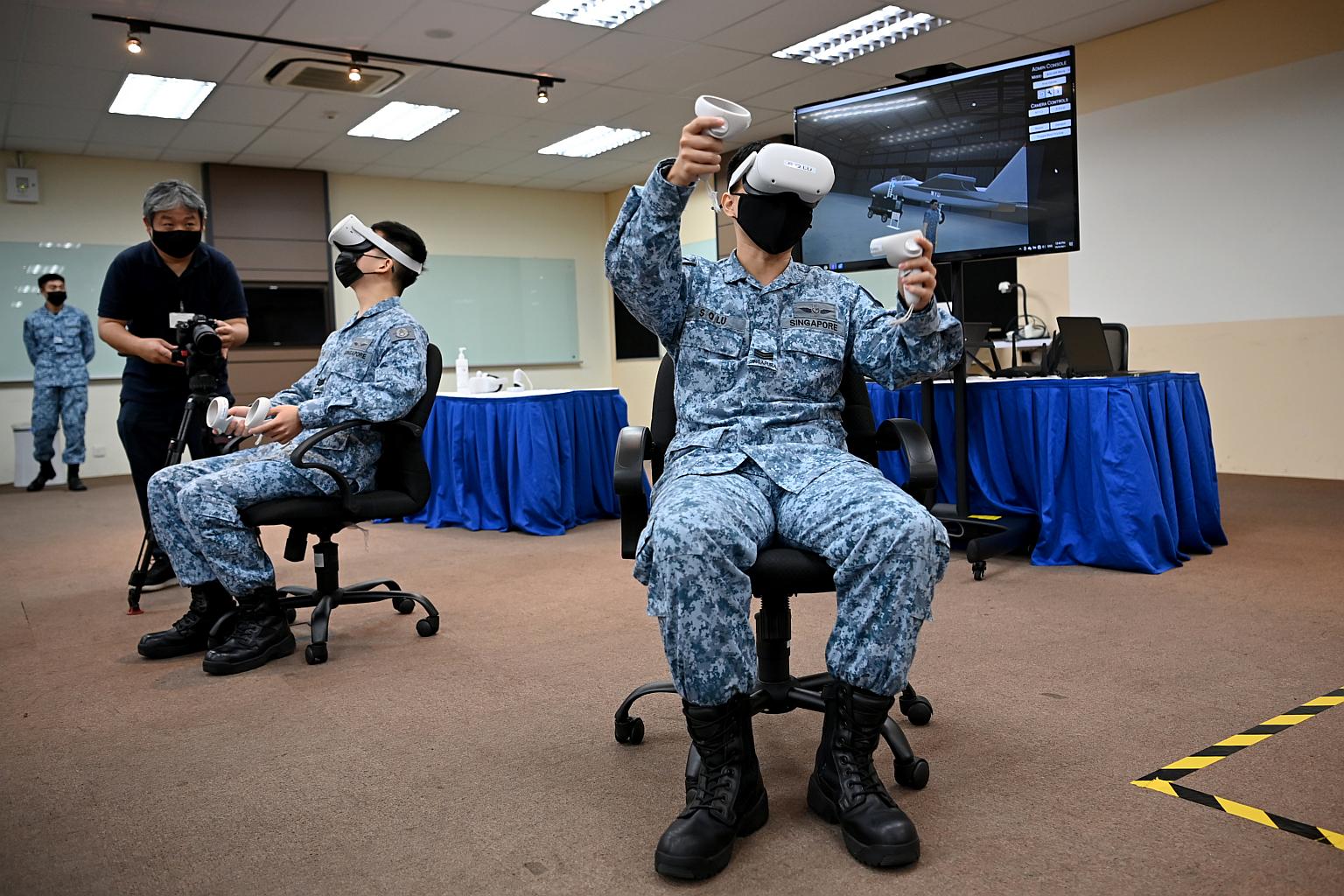RSAF technician trainees now assessed using virtual reality 'escape rooms'
Sign up now: Get ST's newsletters delivered to your inbox
Follow topic:
SINGAPORE - Other than paper quizzes and oral assessments, technician trainees in the Republic of Singapore Air Force (RSAF) are now also tested by playing a virtual reality (VR) game.
Trainees don VR headsets to access the newly developed "escape room", where they complete puzzles that test their knowledge and skills, such as on aircraft maintenance tasks, as they advance from one room to the next.
"One advantage is safety," said Third Sergeant Li Mingyang, an air force technician who helped to develop the escape room. "We can afford to make mistakes without fear of severe consequences."
It also injects an element of fun, the 20-year-old full-time national serviceman told reporters on Wednesday (Sept 29). He added that he has seen trainees bond with their coursemates in lessons he has helped to conduct, as well as build teamwork and communications skills.
Three batches of trainees have used the VR escape room as part of the assessment for their two-month air force technician course at the Air Force Training Command (AFTC) in Paya Lebar since March.
This was among the learning tools showcased on Wednesday during a visit by Senior Minister of State for Defence Zaqy Mohamad.
The training command provides foundation training for all RSAF airmen and women, from aspiring pilots to air warfare officers and air force engineers.
Speaking to reporters after his visit, Mr Zaqy said that the innovations have enabled the RSAF to perform at a high level, and brought gamification and realism to the fore.
"Some of these developments have also enabled us to engage our trainees better," he said, noting that some of the innovations came from the trainees themselves.
Another VR learning tool demonstrated on Wednesday trains ground-based air defence crew on the ability to recognise aircraft in the air.
This system is also meant to increase trainee engagement and enable instructors to provide targeted and immediate feedback, said the Ministry of Defence.
The RSAF is also exploring the use of advanced high-fidelity simulators that are paired with biometric sensors to better train and assess pilots.
The system collects "non-invasive psychophysiological" measurements, such as eye movement, heart rate and facial expressions while the trainee is in the simulator, to gain insights into a trainee's performance.
Senior Lieutenant-Colonel James Phang, 46, who is head of Training Development Group at AFTC, said the move towards more "learner-centric" training programmes began more than 10 years ago.
The younger generation of learners are "digital natives", he said, which means they are comfortable with using mobile platforms and self-directed learning.
"So... we've embarked in a large way to explore the learning technologies available - looking at other militaries, other higher learning institutes, as well as approaching different companies," he said.
Another learning tool, an air traffic control simulator, provides various virtual environments for realistic training in runway management and control of airborne aircraft within an airbase area.
Set up in 2014, the simulator has been a boon for air traffic control officers in training, such as Lieutenant Denise Looi, 23.
She said a key advantage was the ability to simulate emergency scenarios that are very rare in real life, such as an aircraft that is attempting to land while on fire.
"Being able to practise how to react quickly, plan and take the necessary mitigation actions - it helps us build confidence and competencies along the way."
Learning in virtual reality
The Republic of Singapore Air Force (RSAF) is using technology to further improve training outcomes, from a virtual reality "escape room" to an air traffic control simulator. Here are some of the innovations showcased.
Air traffic control simulator

LTA Denise Looi (left) and 2LT Stephen Ng working in the air traffic control simulator at the AFTC.
ST PHOTO: LIM YAOHUI
- A virtual control tower with a 360-degree view simulates various environments and emergency scenarios to train air traffic controllers.
- Every aircraft operated by the RSAF can be simulated, in conditions such as day or night, and rainy or cloudy weather.
Pilot assessment system
- The system collects data, such as a trainee's eye movement, heart rate and facial expressions while he is in the simulator.
- Analysis of the reactions of each pilot trainee can help to improve their flying performance.
Training safety behaviour
- Using virtual reality goggles, air force engineer trainees can practise their safety habits in a virtual environment while performing routine maintenance tasks. They can be exposed to the consequences of their mistakes.
- Developed in April, this prototype is still under trial.
Identifying aircraft in virtual reality

Specialist Cadet Trainee Oliveiro Nicholas Nelson using the Virtual Reality Dynamic Aircraft Recognition Training System to view aircraft models.
ST PHOTO: LIM YAOHUI
- The system is meant to train ground-based air defence crew to identify different aircraft through the sound of the engines and visual features such as the number of turboprops.
- This is done by using virtual reality goggles to observe different aircraft in a simulated environment.
Virtual reality escape room

3SG Li Ming Yang (second left) and 3SG Lu Shaoqin (right) going through the escape room simulation, at RSAF's Air Force Training Command (AFTC) on Sept 29, 2021.
ST PHOTO: LIM YAOHUI
- Air force technician trainees have to solve puzzles that test their proficiency and knowledge, in areas such as aircraft maintenance tasks and safety awareness.
- Up to four trainees can take part at once. It is meant to allow collaborative learning and teach effective teamwork and clear communication.

